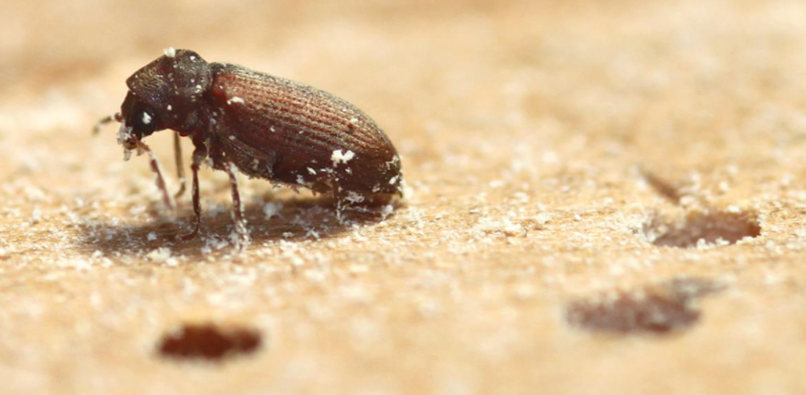House borer has been with us humans from the day we made our dwellings from dead timber. Before that time, the insects concerned themselves solely with tunnelling into (and recycling) fallen logs in the forests. A very useful occupation, I’d say.
Untreated timbers are still perceived by pregnant adult borer beetles as a very suitable fodder for the larvae, especially when there is a wee bit of moisture and yeast around to aid in the digestion of all that cellulose.
She will lay her eggs in old nail holes, exit holes, or cracks in the wood, and particularly loves the end grain of a piece of timber. The larvae emerge and bore straight into the wood; their entrance holes are too small to be noticed by a mortal human being.
Inside they subsist on a very boring diet for at least two years (if the timber is very suitable) – in some cases they’ll take four years to complete their life cycle. It probably pays to stress the fact that bone-dry and yeast-free (or fungus-free) timbers are not great food sources for these destructive beetles. Relatively wet timbers on the south side of the house or in the vicinity of bathrooms are a different story!
When they are ready to pupate, usually in autumn time, they tend to tunnel towards the surface of the timber, so that their exit in spring can be swift and effortless. In November the adult beetles (small dark brown, about 4 - 5 mm long beetles) start chewing their way out, leaving the characteristic, small but visible borer holes behind. Emergence can take place from November until well into summer.
Although the beetles do not feed, they may live for four weeks, in which they find a partner and ensure that preparations are well under way to create a new Generation of domestic borer larvae. Often you can find the beetles in large numbers, dead on a windowsill after they have forcefully tried to exit through a closed window.
Control is tricky. Injection of borer fluids into the exit holes is absolutely useless: the borers have already left and only few exit holes will be used as oviposition sites by the gravid females.
The idea is to cover at risk timber (untreated, non-tanalised timber) with a residual material that kills either the emerging beetles and egg laying females, or the hatching first instar grubs of the borer. But since DDT went out of fashion, this is not easily achieved.
Perhaps a good soaking with diesel is exactly the lethal barrier you might be looking for, although the stench will wear anybody down, after a while.
If you can be bothered, a “borer bomb” could cover most surfaces with a residue, but you’ll need to use a number of them for your average house size to get a good deposit. These days those borer bombs are basically aerosol cans that self-discharge after triggering.
A permethrin aerosol can, used to residually treat airplanes will work quite well too (contact Safeworx); aim at the exposed timber and spray the surface
Remember to start your first treatment on 31 October, so that the first emerging borer will literally hit the ground running (or flying) on the 1st of November. Often a second deposit may be necessary in early December to cover the total emergence period.
The idea here is to let the emerging beetles come in contact with this lethal substance, be it permethrin or the active ingredient of the bomb.
Of course, you can always call in the professional pest control operator, but you now know to book them at the right time.
LISTEN ABOVE
Take your Radio, Podcasts and Music with you










